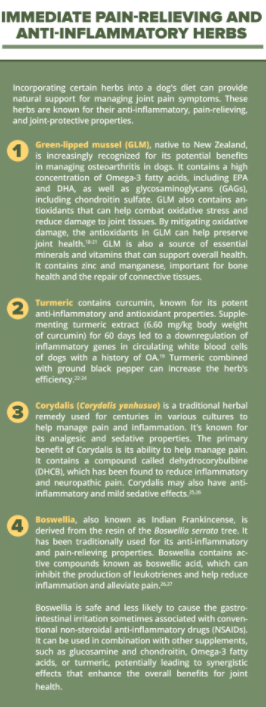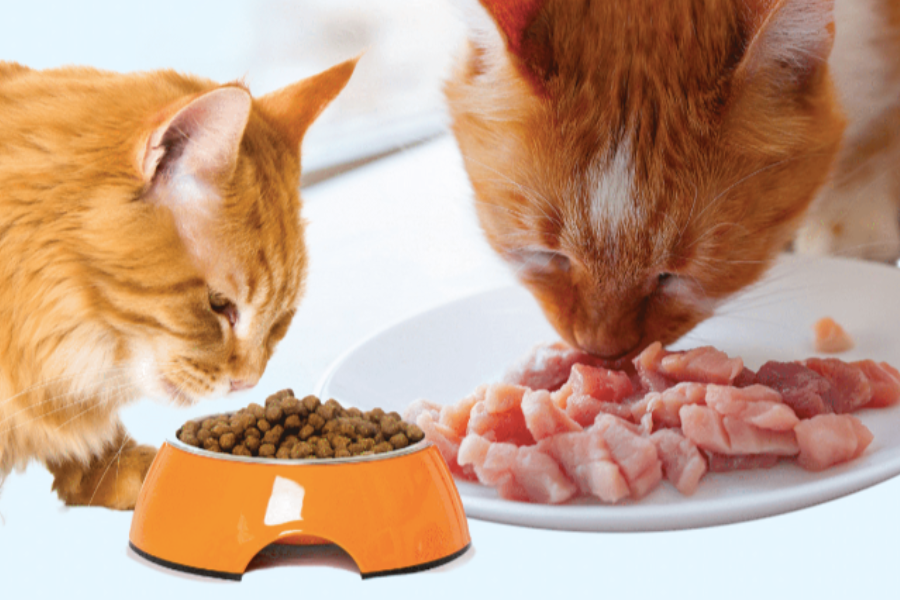Used alongside weight management and adequate exercise, nutritional strategies for joint health in dogs include a balanced diet, glycosaminoglycans, and quick-acting pain-relieving herbs.
Supporting canine joint health through nutrition begins with a complete and balanced diet. Such a diet must provide protein, glucose, vitamins, minerals, Omega-3 fatty acids, and antioxidants. In combination with glycosaminoglycans and immediate pain-relieving and anti-inflammatory herbs, these dietary components cater to all aspects of the joint. Employing these nutritional strategies along with healthy weight maintenance and adequate exercise is crucial to supporting your canine patients joint health.
The building blocks of long-term joint health
Macronutrients
Including proteins, fats, and glucose, macronutrients play essential roles in the overall joint health of dogs. The right balance of these macronutrients is vital. High quality protein is crucial for maintaining muscle mass; strong muscles can help support and stabilize joints. Adequate protein intake ensures the body has the necessary components to repair and maintain joint tissues.
Fats, especially Omega-3 fatty acids, help reduce inflammation and benefit joint health. In particular, EPA (eicosapentaenoic acid) and DHA (docosahexaenoic acid) can be highly beneficial due to their anti-inflammatory properties. Omega-3 fatty acids can alter the production of inflammatory eicosanoids, prostaglandins, and leukotrienes, leading to a decreased inflammatory response1,2 By integrating into the cell membranes of joint tissues, Omega-3s can lead to the production of less potent inflammatory compounds.
Chronic systemic inflammation can lead to cartilage degradation. By reducing whole-body inflammation, Omega-3 fatty acids help protect the joints against further damage from leukocyte-mediated tissue injury. They also help improve blood flow to the tissues, including those in the joints. Omega-3s are not direct pain reducers, but by decreasing joint inflammation and degradation, they can indirectly lead to a reduction in pain and discomfort for the dog.3,4
Omega-3 fatty acids also contribute to brain and skin health, and can help maintain a healthy coat. This overall boost in health can indirectly support a dog’s ability to cope with the challenges of joint disease.5,6
The therapeutic dose of EPA and DHA for a dog with osteoarthritis is 147 mg/kg/day, with the NRCs safe upper limit being 175 mg/kg/day. AAFCO does not have a minimum EPA/DHA requirement for adult canine maintenance. In contrast, the EPA/DHA requirement for canine growth and reproduction diets is 0.05% dry matter basis or 10 mg/100 kcal.
Antioxidants
Antioxidants play a crucial role in managing degenerative joint disease in dogs by combating oxidative stress and inflammation, two key factors contributing to joint injury progression.?
 Oxidative stress occurs when an imbalance occurs between free radicals (unstable molecules that can damage cells) and antioxidants in the body. This stress can contribute to inflammation and damage to joint tissues. Antioxidants neutralize free radicals, thereby protecting the cells, including those in the joints, from damage.
Oxidative stress occurs when an imbalance occurs between free radicals (unstable molecules that can damage cells) and antioxidants in the body. This stress can contribute to inflammation and damage to joint tissues. Antioxidants neutralize free radicals, thereby protecting the cells, including those in the joints, from damage.
Many antioxidants have anti-inflammatory properties. By reducing inflammation, they can help alleviate pain and slow the progression of joint damage. The synovium can be affected by oxidative stress and inflammation; antioxidants help protect the synovium, thereby maintaining the health of the entire joint structure.
By protecting cartilage from oxidative damage, antioxidants contribute to preserving joint function and reducing pain. Vitamins such as C and E are well-known antioxidants. Unlike humans, canines can synthesize endogenous vitamin C production, which can be upregulated with increased oxidative stress. Other dietary compounds like carotenoids and flavonoids, found in various fruits and vegetables, also have antioxidant properties.7
Micronutrients can help reduce inflammation, repair and protect joint structures, and improve overall joint function.
- Vitamin C is a potent antioxidant that helps combat oxidative stress and reduce inflammation in the joints. It also plays a role in collagen synthesis, an essential component of cartilage.
- Vitamin E has strong antioxidant properties that help protect joint tissues from oxidative damage. It supports the immune system and can help alleviate inflammation in the joints.8
- Zinc and manganese are essential for bone health and assist in forming connective tissues and cartilage. They are also involved in the production of collagen and proteoglycans.
- Selenium has antioxidant properties that can help protect the joints from oxidative stress and damage.
Glycosaminoglycans
These important nutrients are obtained through a wild canines natural diet, mainly by consuming the tissues of prey animals which are rich in this compound.9 The natural diet of a wild canine is diverse and balanced enough to support joint health.
- Joint and connective tissues: Wild canines consume the entire carcass of their prey, which includes the joints and connective tissues. Joint fluid is a source of hyaluronic acid, and connective tissue is one of the best dietary sources of collagen.
- Bone and marrow: Wild canines often chew on the bones of their prey. This not only provides calcium and other minerals but also exposes the bone marrow. Bone marrow, and the cartilage caps on the ends of bones, can be sources of glucosamine and chondroitin.
- Ligaments and tendons: These parts of the prey’s body are rich in collagen and other proteins that support joint health. While they don’t directly provide glucosamine, they supply essential nutrients for maintaining joint integrity and function.
A dog’s body, much like the human body, can synthesize endogenous glucosamine. This is crucial for maintaining the health and resilience of cartilage. In healthy dogs, this process ensures the cartilage is maintained and repaired as needed. However, as dogs age, or suffer from joint conditions like arthritis, the natural production of glucosamine can decrease, potentially leading to the degradation of cartilage and the onset of arthritis symptoms.
Additionally, domestic dogs may not always have access to such a range of natural nutrients in their diets, especially if they are fed a highly-processed commercial diet. The meat-processing industry is structured to first retrieve the parts of the animal that humans consume, which is around 60% of the animal. The other parts of the carcass can be value added material for different industries, particularly the pet food industry. In the dismemberment of a beef cow, for example, the muscle meats and organs are utilized in the human and pet food industries. However, the long bones of cattle are difficult to grind for a calcium source, and the cartilage caps are labor-intensive to harvest. In the current meat harvesting industry, long bones with cartilage caps are disposed of via the rendering process. Although smaller bones may make their way into pet food, most of the cartilage is rendered, leaving standard pet food void of the nutrients needed to support joint health.
Without access to natural joint-supporting nutrients, the following supplemental glycosaminoglycans (GAGs) should be used with commercially-processed pet foods.
- Glucosamine is a building block for cartilage proteoglycans. Cartilage comprises several components, including water, collagen, proteoglycans (which attract and retain water to maintain the spongy nature of cartilage), and chondrocytes (cells that produce cartilage).
Glucosamine regulates collagen synthesis in cartilage and may provide mild anti-inflammatory effects. Therefore, it can help in the formation and repair of cartilage as well as play a role in producing viscose synovial fluid.10-13
When it comes to supplementing glucosamine for joint health in dogs, the dosage is not based on the amount found in natural cartilage, but on the amount shown to be beneficial in clinical studies. For dogs, a common glucosamine dosage is often in the range of 20 mg per pound (about 44 mg/kg) of body weight per day.
- Chondroitin?contributes to cartilage resilience by attracting water into the tissue, making it more elastic and capable of withstanding stress. It can help block the destructive enzymes that break down cartilage and joint fluid. By inhibiting these enzymes, chondroitin supports the maintenance of cartilage and prevents its breakdown. A chondroitin dose of 15-30 mg/kg has been suggested, but there are few in vitro studies that provide bioavailability and pharmacokinetic data.13,13
- Hyaluronic Acid (HA) occurs naturally in the body, and is found in high concentrations in the synovial fluid that lubricates the joints, as well as in connective tissues and skin. Its known for its lubricating and shock-absorbing properties. HA contributes to the viscosity of synovial fluid, providing a lubricating layer. This can reduce friction and wear on the cartilage, potentially alleviating pain and improving mobility. By maintaining elasticity and viscosity of the joint fluid, HA helps absorb the shocks to the joints that occur during movement, protecting them from further damage. HA can also reduce inflammation and is involved in cartilage regeneration and repair.
Dietary sources of glucosamine, chondroitin, and hyaluronic acid are the building blocks of cartilage and synovial fluid. Therefore, when used together, they are thought to have a synergistic effect. Veterinarians commonly recommend glucosamine and chondroitin for treating osteoarthritis in canines despite the lack of compelling scientific evidence demonstrating clinical benefits. Their effectiveness can vary between individuals, and they are generally considered part of a long-term management strategy rather than a short-term solution.12,13
- Collagen is an essential protein naturally found in the body. It is a key component of cartilage, tendons, and ligaments, helping to maintain the strength and elasticity of these tissues.14-17 Collagen acts as a “cushion” within the joints, allowing bones to move smoothly over each other. As dogs get older, collagen production decreases, leading to joint health deterioration. Collagen supplements, often derived from marine sources or chicken sternum, can help maintain collagen levels in the dogs body, potentially aiding in joint health.
Nutritional strategies for managing joint health in dogs involve a holistic approach: one that relies on a balanced diet rich in antioxidants and Omega-3 fatty acids, appropriate exercise, weight management, and GAGS such as glucosamine, chondroitin, and hyaluronic acid. With this strategy and the addition of quick-acting, pain-relieving herbs such as Corydalis, boswellia, and turmeric (see sidebar on page xx), you are caring for your canine patients short- and long-term joint health.
_______________________________________________________________________
1Adler N, Schoeniger A, Fuhrmann H. (2018) Polyunsaturated fatty acids influence inflammatory markers in a cellular model for canine osteoarthritis. Journal of Animal Physiology and Animal Nutrition 102, e623-e632.
2Mehler SJ, May LR, King C, et al. (2016) A prospective, randomized, double blind, placebo-controlled evaluation of the effects of eicosapentaenoic acid and docosahexaenoic acid on the clinical signs and erythrocyte membrane polyunsaturated fatty acid concentrations in dogs with osteoarthritis. Prostaglandins, Leukotrienes, and Essential Fatty Acids 109, 1-7.
3Buddhachat K, Siengdee P, Chomdej S, et al. (2017) Effects of different omega-3 sources, fish oil, krill oil, and green-lipped mussel against cytokine-mediated canine cartilage degradation. In Vitro Cellular & Developmental Biology. Animal 53, 448-457.
4Moreau M, Troncy E, Castillo DEL, et al. (2013) Effects of feeding a high omega-3 fatty acids diet in dogs with naturally occurring osteoarthritis. Journal of Animal Physiology and Animal Nutrition 97, 830-837.
5Fritsch DA, Allen TA, Dodd CE, et al. (2010) A multicenter study of the effect of dietary supplementation with fish oil omega-3 fatty acids on carprofen dosage in dogs with osteoarthritis. Journal of the American Veterinary Medical Association 236, 535-539.
6Barrouin-Melo SM, Anturaniemi J, Sankari S, et al. (2016) Evaluating oxidative stress, serological- and haematological status of dogs suffering from osteoarthritis, after supplementing their diet with fish or corn oil. Lipids in Health and Disease 15, 139.
7Tanprasertsuk J, Tate DE, Shmalberg J. Roles of plant-based ingredients and phytonutrients in canine nutrition and health. J Anim Physiol Anim Nutr (Berl). 2022 May;106(3):586-613. doi: 10.1111/jpn.13626. Epub 2021 Sep 8. PMID: 34495560; PMCID: PMC9291198.
8Chin KY, Ima-Nirwana S. (2018) The role of vitamin E in preventing and treating osteoarthritis – a review of the current evidence. Frontiers in Pharmacology 9, 946.
9Pye C, Clark N, Bruniges N, Peffers M, Comerford E. (2024), Current evidence for non-pharmaceutical, non-surgical treatments of canine osteoarthritis. J Small Anim Pract, 65: 3-23.
10Altman RD. (2009) Glucosamine therapy for knee osteoarthritis: pharmacokinetic considerations. Expert Review of Clinical Pharmacology 2, 359-371.
11Barbeau-Grégoire M, Otis C, Cournoyer A, et al. (2022) A 2022 systematic review and meta-analysis of enriched therapeutic diets and nutraceuticals in canine and feline osteoarthritis. International Journal of Molecular Sciences 23, 10384.
12Gupta RC, Canerdy TD, Lindley J, Konemann M, Minniear J, Carroll BA, et al..?Comparative therapeutic efficacy and safety of type-II collagen (UC-II), glucosamine and chondroitin in arthritic dogs: pain evaluation by ground force plate.?J Anim Physiol Anim Nutr.?(2012)?96:7707. 10.1111/j.1439-0396.2011.01166.x.?
13McCarthy G, O’Donovan J, Jones B, McAllister H, Seed M, Mooney C.?Randomised double-blind, positive-controlled trial to assess the efficacy of glucosamine/chondroitin sulfate for the treatment of dogs with osteoarthritis.?Vet J.?(2007)?174:5461. 10.1016/j.tvjl.2006.02.
14Comblain F, Barthélémy N, Lefèbvre M, et al. (2017) A randomized, double-blind, prospective, placebo-controlled study of the efficacy of a diet supplemented with curcuminoids extract, hydrolyzed collagen and green tea extract in owner’s dogs with osteoarthritis. BMC Veterinary Research 13, 395.
15Deparle LA, Gupta RC, Canerdy TD, et al. (2005) Efficacy and safety of glycosylated undenatured type-II collagen (UC-II) in therapy of arthritic dogs. Journal of Veterinary Pharmacology and Therapeutics 28, 385-390.
16Vandeweerd JM, Coisnon C, Clegg P, et al. (2012) Systematic review of efficacy of nutraceuticals to alleviate clinical signs of osteoarthritis. Journal of Veterinary Internal Medicine 26, 448-456.
17Varney JL, Fowler JW, Coon CN. (2022) Impact of supplemented undenatured type II collagen on pain and mobility in healthy Labrador retrievers during an exercise regimen. Translational Animal Science 6, txac12.
18Hielm-Björkman A, Tulamo RM, Salonen H. et al. (2009) Evaluating complementary therapies for canine osteoarthritis part I: green-lipped mussel (Perna canaliculus). Evidence-based Complementary and Alternative Medicine 6, 397263.
19Sgorlon S, Stefanon B, Sandri M, Colitti M. (2016).?Nutrigenomic activity of plant derived compounds in health and disease: results of a dietary intervention study in dog.?Research in Veterinary Science,?109(December), 142148.?
20Servet E, Biourge V, Marniquet P. (2006) Dietary intervention can improve clinical signs in osteoarthritic dogs. The Journal of Nutrition 136, 1995S-1997S.
21Bierer TL, Bui LM. (2002) Improvement of arthritic signs in dogs fed green-lipped mussel (Perna canaliculus). The Journal of Nutrition 132, 1634S-1636S.
22Paultre K, Cade W, Hernandez D, et al. (2021) Therapeutic effects of turmeric or curcumin extract on pain and function for individuals with knee osteoarthritis: a systematic review. BMJ Open Sport & Exercise Medicine 7, e000935.
23Hewlings SJ, Kalman DS. Curcumin: A Review of Its Effects on Human Health. Foods. 2017 Oct 22;6(10):92. doi: 10.3390/foods6100092. PMID: 29065496; PMCID: PMC5664031.
24Henrotin Y, Clutterbuck AL, Allaway D, et al. (2010) Biological actions of curcumin on articular chondrocytes. Osteoarthritis and Cartilage 18, 141-149.
25Alhassen L, Dabbous T, Ha A, Dang LHL, Civelli O. The Analgesic Properties of?Corydalis yanhusuo. Molecules. 2021 Dec 10;26(24):7498. doi: 10.3390/molecules26247498. PMID: 34946576; PMCID: PMC8704877.
26Martello E, Bigliati M, Adami R, Biasibetti E, Bisanzio D, Meineri G, Bruni N. Efficacy of a dietary supplement in dogs with osteoarthritis: A randomized placebo-controlled, double-blind clinical trial. PLoS One. 2022 Feb 16;17(2):e0263971.
27Reichling J, Schmökel H, Fitzi J, Bucher, S. , & Saller, R. (2004).?Dietary support with Boswellia resin in canine inflammatory joint and spinal disease.?Schweizer Archiv Fur Tierheilkunde,?146(2), 7179. 10.1024/0036-7281.146.2.71.







